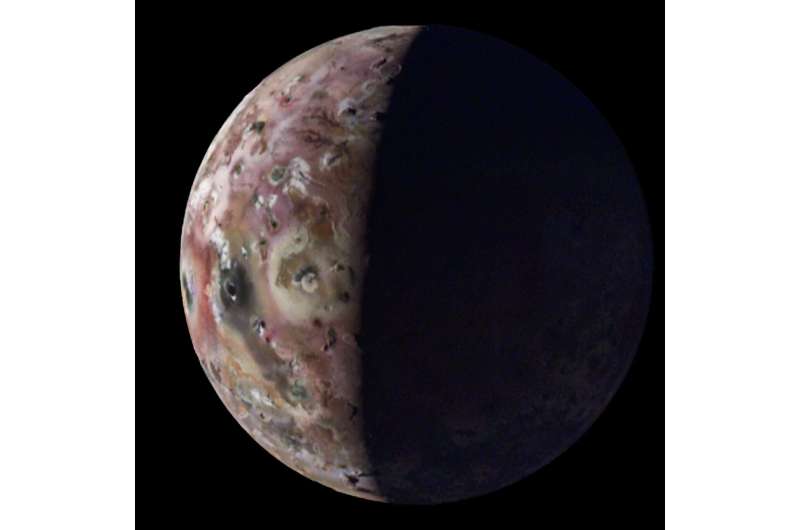On April 9, during the 60th flyby of Jupiter by NASA’s Juno spacecraft, the JunoCam instrument captured a view of Jupiter’s moon Io and captured the first image of the Antarctic region. /MSSS; Image processing: Gerald Eichstdt/Thomas Thomopoulos (CC BY)
Scientists on NASA’s Juno mission to Jupiter have transformed data collected during two recent flybys of the planet into animations that highlight two of the Jovian moon’s most striking features: a mountain and an almost glassy surface. Cooling lava lake. Other recent scientific results from solar-powered spacecraft include updates on Jupiter’s polar cyclones and water abundance.
Juno principal investigator Scott Bolton announced the new findings at a press conference at the European Geophysical Union Congress in Vienna on Wednesday, April 16.
Juno flew extremely close by Io in December 2023 and February 2024, getting within about 930 miles (1,500 kilometers) of the surface, obtaining the first close-up images of the moon’s northern latitudes.
“Io is full of volcanoes, and we captured some of them in action,” Bolton said. “We also got some fantastic close-ups and other data of a 200-kilometer-long (127-mile-long) lava lake called Loki Patera. Stunning detail shows these crazy islands embedded on the edge of a potential lava lake. We Specular reflections from the lake water recorded by the instrument indicate that parts of Io’s surface are as smooth as glass, reminiscent of obsidian glass formed by volcanoes on Earth.
Maps generated from data collected by Juno’s Microwave Radiometer (MWR) instrument show that Io not only has a relatively smooth surface compared to Jupiter’s other Galilean moons, but also has poles that are cooler than those at mid-latitudes.
pole position
During Juno’s extended mission, the spacecraft will fly closer to Jupiter’s north pole with each pass. This change in direction allows the MWR instrument to improve the resolution of Jupiter’s north polar cyclones. The data allow for multi-wavelength comparisons across the poles, revealing that not all polar cyclones are the same.
“Perhaps the most striking example of this difference can be found in the central cyclone at Jupiter’s north pole,” said Juno project scientist Steve Levine of NASA’s Jet Propulsion Laboratory in Southern California.
“It is clearly visible in both infrared and visible light imagery, but its microwave signature is not nearly as strong as other nearby storms. This tells us that its subsurface structure must be very different from other cyclones. The MWR team continues to collect more and more With better microwave data per orbit, we expect to develop more detailed 3D maps of these interesting polar storms.
Jupiter water
One of the mission’s main scientific goals is to collect data that will help scientists better understand Jupiter’s water abundance. To do this, the Juno science team is not looking for liquid water. Instead, they are seeking to quantify the presence of oxygen and hydrogen molecules (the molecules that make up water) in Jupiter’s atmosphere. Accurate estimates are crucial to piecing together the mystery of the solar system’s formation.
Jupiter was probably the first planet to form and contains most of the gas and dust that was not incorporated into the Sun. The abundance of water also has important effects on the gas giant’s meteorology (including how winds flow on Jupiter) and internal structure.
In 1995, NASA’s Galileo probe provided an early data set of Jupiter’s water abundance during the spacecraft’s 57-minute descent into the planet’s atmosphere. But the data raised more questions than answers, showing that the gas giant’s atmosphere is unexpectedly hot, contrary to what computer models suggested would be the absence of water.
“The probe did amazing science, but its data was so far from our models of Jupiter’s water abundance that we considered whether the locations it sampled might be outliers. But before Juno, we couldn’t confirm, ” Bolton said. “Now, based on the latest results from the MWR data, we have determined that the abundance of water near Jupiter’s equator is approximately three to four times greater than that of the Sun, compared to hydrogen. This clearly indicates that the Galileo probe’s entry site was an unusually dry one. area, a desert-like area.
The findings support the idea that water-ice material may have been a source of heavy element enrichment (chemical elements heavier than the hydrogen and helium accreted by Jupiter) during the formation of the gas giants during the formation of the solar system and/or their formation. . Jupiter’s formation remains puzzling, as Juno’s findings on the gas giant’s core indicate a very low abundance of water, a mystery that scientists are still trying to unravel.
Data from the remainder of Juno’s extended mission could be helpful, both by allowing scientists to compare the abundance of water near Jupiter’s polar regions and its equatorial regions, and by providing more clues to the structure of Jupiter’s dilute core.
Juno’s latest flyby of Io came on April 9, bringing the spacecraft within about 10,250 miles (16,500 kilometers) of the moon’s surface. It will perform its 61st flyby of Jupiter on May 12.
citation: NASA’s Juno provides aerial view of mountains and lava lakes on Io (2024, April 18), Retrieved April 19, 2024, from https://phys.org/news/2024-04 -nasa-juno-aerial-views-mountain.html
This document is protected by copyright. No part may be reproduced without written permission except in the interests of fair dealing for private study or research purposes. Content is for reference only.
#NASAs #Juno #spacecraft #birdseye #view #mountains #lava #lakes
Image Source : phys.org
